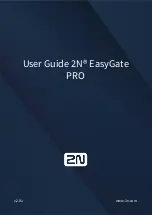
Chapter 8 Wireless Screen
NWA-3166 User’s Guide
113
8.3.2 ATC
Automatic Traffic Classifier (ATC) is a bandwidth management tool that prioritizes
data packets sent across the network. ATC assigns each packet a priority and then
queues the packet accordingly. Packets assigned a high priority are processed
more quickly than those with low priority if there is congestion, allowing time-
sensitive applications to flow more smoothly. Time-sensitive applications include
both those that require a low level of latency and a low level of jitter such as Voice
over IP or Internet gaming, and those for which jitter alone is a problem such as
Internet radio or streaming video.
ATC assigns priority based on packet size, since time-sensitive applications such
as Internet telephony (Voice over IP or VoIP) tend to have smaller packet sizes
than non-time sensitive applications such as FTP (File Transfer Protocol). The
following table shows some common applications, their time sensitivity, and their
typical data packet sizes. Note that the figures given are merely examples - sizes
may differ according to application and circumstances.
When ATC is activated, the device sends traffic with smaller packets before traffic
with larger packets if the network is congested.
best effort
(WMM_BEST_EFFORT
)
Typically used for traffic from applications or devices that lack
QoS capabilities. Use best effort priority for traffic that is less
sensitive to latency, but is affected by long delays, such as
Internet surfing.
background
(WMM_BACKGROUND
)
This is typically used for non-critical traffic such as bulk transfers
and print jobs that are allowed but that should not affect other
applications and users. Use background priority for applications
that do not have strict latency and throughput requirements.
Table 23
WMM QoS Priorities
PRIORITY LEVEL
DESCRIPTION
Table 24
Typical Packet Sizes
APPLICATION
TIME
SENSITIVITY
TYPICAL PACKET
SIZE (BYTES)
Voice over IP
(SIP)
High
< 250
Online Gaming
High
60 ~ 90
Web browsing
(http)
Medium
300 ~ 600
FTP
Low
1500
Summary of Contents for NWA-3166
Page 2: ......
Page 15: ...15 PART I Introduction Introduction 17 The Web Configurator 29 Tutorials 33 ...
Page 16: ...16 ...
Page 32: ...Chapter 2 The Web Configurator NWA 3166 User s Guide 32 ...
Page 64: ...Chapter 3 Tutorials NWA 3166 User s Guide 64 ...
Page 66: ...66 ...
Page 70: ...Chapter 4 Status Screen NWA 3166 User s Guide 70 ...
Page 122: ...Chapter 8 Wireless Screen NWA 3166 User s Guide 122 ...
Page 128: ...Chapter 9 SSID Screen NWA 3166 User s Guide 128 ...
Page 158: ...Chapter 14 IP Screen NWA 3166 User s Guide 158 ...
Page 166: ...Chapter 15 Rogue AP Detection NWA 3166 User s Guide 166 ...
Page 186: ...Chapter 17 Internal RADIUS Server NWA 3166 User s Guide 186 ...
Page 213: ...Chapter 19 Log Screens NWA 3166 User s Guide 213 ...
Page 214: ...Chapter 19 Log Screens NWA 3166 User s Guide 214 ...
Page 235: ...Chapter 20 VLAN NWA 3166 User s Guide 235 ...
Page 236: ...Chapter 20 VLAN NWA 3166 User s Guide 236 ...
Page 270: ...Appendix B Wireless LANs NWA 3166 User s Guide 270 ...
Page 300: ...Appendix D IP Addresses and Subnetting NWA 3166 User s Guide 300 ...
Page 308: ...Appendix E Text File Based Auto Configuration NWA 3166 User s Guide 308 ...
Page 314: ...Appendix F How to Access and Use the CLI NWA 3166 User s Guide 314 ...
Page 326: ...Appendix H Customer Support NWA 3166 User s Guide 326 ...
Page 332: ...Index NWA 3166 User s Guide 332 ...
















































